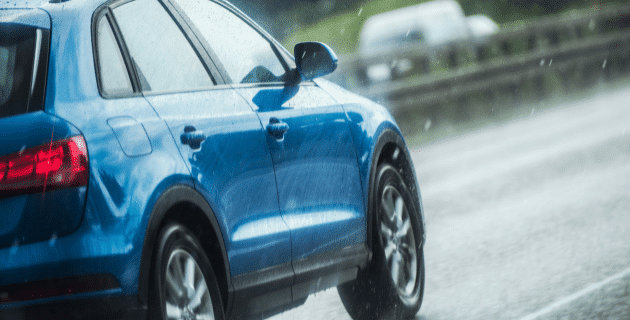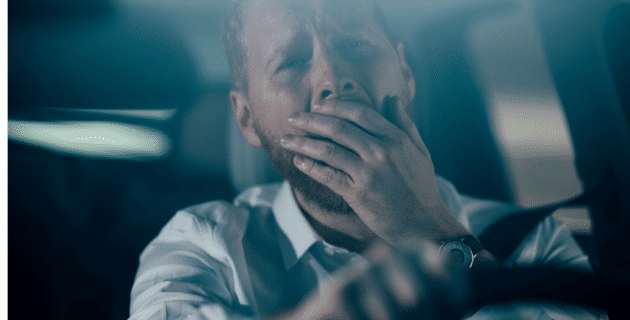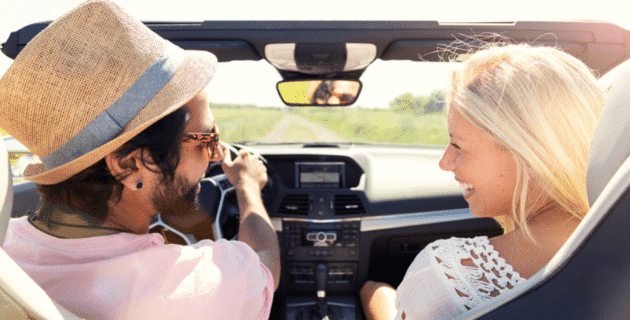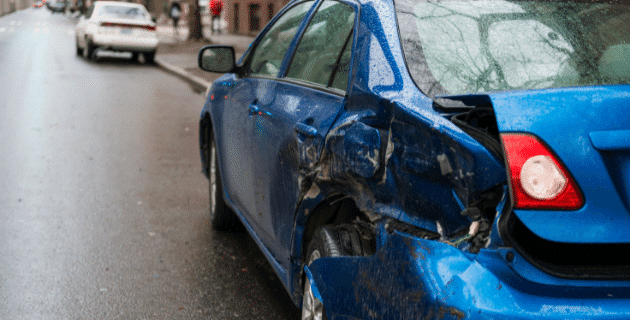
by California Casualty | Auto Insurance Info |
From hail to high winds, flooding, and more, spring storms can do some real damage — and not just to your home and property. These intense storms can also take their toll on your car.
Here are some ways you can protect your vehicle from spring storms.
Take cover – and cover-up — during hailstorms.
Hailstorms do billions of dollars of damage each year, according to the Insurance Information Institute. If you live in one of the states that typically receives a lot of hail, your car could be at even greater risk. But even if you don’t, it only takes one bad hailstorm to dent your vehicle or crack your windshield.
-
- If you have a garage or barn, park your car inside. Being in an enclosed structure will help protect your car from hailstones and flying debris.
- It may be a bit inconvenient but you can find covered parking in malls or parking garages. Park above the ground floor to minimize contact with water in case there is flooding.
- If you cannot park inside, move your car away from trees. Park near the side of a building or your house for some protection.
- Cover your vehicle with a car cover. You can buy one or make your own with blankets. Secure the blankets with duct tape; while it may leave a sticky residue, it will not damage your paint.
- If you’re driving when a hailstorm hits, pull over. Hailstones fall at a pretty good speed. When you add your car’s forward motion, that actually increases the impact.
Stay far from trees and other cars in high winds.
High or straight-line winds can leave destruction in their wake, from downed trees to flying debris. Check with your local weather service on wind speeds and know what wind can do. Winds traveling at 50 mph can move patio furniture. At 60 mph, they can pick up a car and shatter windows.
-
- Park away from trees, which could potentially fall or drop heavy branches on your vehicle. Stay away from power lines, too.
- Park inside if space is available. Reinforced garage doors are helpful if you’re in a place with frequent high winds.
- If time permits, trim your tree branches in advance of the storm. Also, remove any items that could potentially impact your car.
- Remove valuables from your car that could be blown away if winds hit high speeds and shatter your windows. Don’t tape your windows; it’s a myth that tape will help contain the glass and prevent tiny shards from flying around.
- If you’re driving in strong winds, consider pulling over. If you continue driving, keep plenty of space between you and the cars around you.
Stay high and dry when it rains and floods.
Rain and flooding can cause serious problems with your car. Water can damage your engine, electrical components, and interior. Its effects may not even show up immediately. You may have trouble starting your car, or notice premature rusting.
-
- Make sure your windows are rolled up, and your sunroof is closed before a rainstorm. If water gets inside your car, it can cause mold to grow.
- Store important documents for your car in a water-tight bag.
- Park on high ground if possible, or in a garage.
- You can purchase a flood cover that may help to protect your car.
- Avoid driving through pools of water. The water could reach your car’s undercarriage.
- Stay off the roads if you can. Floodwaters can rise quickly and you want to avoid contact with your car.
- If your vehicle stalls in a flooded area, do not remain with your car. Exit your vehicle and get to high ground. It takes just 12 inches of rushing water to carry away a small car and 2 feet of rushing water can carry away most vehicles, according to AAA.
Know what to expect and plan ahead.
Your local town or your state will likely issue severe weather alerts. Getting a heads up on impending storms will help you make the proper preparations ahead of storms this spring.
-
- Download a weather app on your phone for advance notice.
- Research places in case you need to take shelter, including where to park your car.
- Check your tires and make sure they are fully inflated.
- Check your windshield wipers and replace blades that leave streaks.
- Make sure that you have a full tank of gas in case you need to evacuate.
Make sure you have the right insurance coverage to protect your vehicle.
Despite your best efforts to protect your vehicle, sometimes damage happens. But if you have the right insurance coverage, you’ll likely be able to repair or replace your vehicle without large out-of-pocket costs.
-
- Comprehensive coverage is for natural disasters, fires, vandalism, theft, and animals that damage your vehicle. Think of it as “bad luck coverage.” Comprehensive coverage is not usually required unless you’re leasing a vehicle or paying a car loan. However, it’s valuable to protect your car from spring storm damage.
- If your car needs to stay in the shop, an insurance policy with rental car coverage will be most helpful.
- If spring storms damage your car to the extent that it is totaled, your insurance policy will likely pay you for the actual cash value of your car.
- Talk to your insurance agent to see what is covered under your auto policy before spring storms hit!
This article is furnished by California Casualty, providing auto and home insurance to educators, law enforcement officers, firefighters, and nurses. Get a quote at 1.866.704.8614 or www.calcas.com.

by California Casualty | Auto Insurance Info |
Daylight savings may not only be affecting your sleep routine, research shows that daylight savings also has a connection with a surge in fatal car crashes.
During daylight savings time in the spring our clocks “spring forward” one hour, changing the amount of light we receive at certain times of day. Now we are experiencing the sun rising later in the morning and setting later in the evening. Although it’s just an hour difference, it can really take a toll on your body. “The sudden change in clock time can disrupt your sleep pattern, leading to a decrease in total sleep time and reduced sleep quality. This sleep disruption can reduce daytime alertness,” says Dr. Kelly Carden, the president of the American Academy of Sleep Medicine.
Drowsy driving along with now making the morning commute to work in the dark, are why researchers believe the spike in car accidents happen. Let’s look further into why that is.
Drowsy Driving
Drowsy driving is a form of distracted driving – the leading cause of car accidents in the United States. It’s a dangerous combination of fatigue and sleepiness that often happens when the driver has not gotten enough sleep, however drowsy driving can also be a side effect of sleep disorders, medication, drinking, or shift work.
Drowsy driving is responsible for more than 6,400 U.S. deaths annually. Remember, when you drive drowsy, you are not only putting yourself at risk, but you are also putting everyone else on the roadway at risk if you fall asleep, are unable to react in time, or lose control.
Drowsy Driving…
…makes you less able to pay attention to the road.
…slows reaction time if you must brake or steer.
…affects your ability to make good decisions.
The best way to avoid driving drowsy is to make sure you are getting enough sleep at night (the recommended amount for adults is 7 hours) by practicing good sleeping habits. And to avoid any substances that may make you more tired before getting on the road.
Driving in the Dark
With the time change, it’s likely that your morning commute is now entirely in the dark. And while that may not seem like a major change, depth perception and peripheral vision can be compromised in the dark, and the glare of headlights from an oncoming vehicle can temporarily blind or disorient you.
Visibility is also limited to less than 500 ft, meaning there is less time to react in case of an emergency or if something is in the middle of the roadway, like a tire or deer. Because of this, the number of road fatalities triples when it’s dark.
Unfortunately, for those who in situations where drowsy and night driving are unavoidable, like workers with irregular hours or parents of newborns, etc. here are a few tips that you can do behind the wheel to help prevent a crash.
-
- Be aware of your surroundings – watch for other drivers, animals, or obstructions in the roadway that could be hidden by the darkness
- Slow down – don’t be afraid to reduce your speed when visibility is low
- Stay alert to the best of your ability – turn on the air conditioner or some loud music to help you focus and stay awake.
- Don’t look directly into headlights – avoid bright headlights by starting at the white line on the right-hand side of the road when other cars are passing.
- Avoid common distractions– like food or your phone
- Limit your night driving – if it’s not necessary, stay in!
- Always follow the rules of the road– never speed or break the law to get to your destination quicker
- If you know you cannot drive– ask someone for a ride or call a rideshare
And in the case of an accident make sure you are covered, by having the proper auto insurance protection.
This article is furnished by California Casualty, providing auto and home insurance to educators, law enforcement officers, firefighters, and nurses. Get a quote at 1.866.704.8614 or www.calcas.com.

by California Casualty | Auto Insurance Info, Homeowners Insurance Info, Safety |
There’s a reason why a tornado strikes immediate fear for those in its path. These violent storms can flip cars, uproot trees, and destroy entire properties. Their powerful winds can even lift objects hundreds of feet off the ground and leave complete devastation in their wake.
Here’s what you need to know to keep your home, your vehicle, and your family safe from tornadoes and high winds.
What is a tornado?
A tornado is a spinning, funnel-shaped cloud usually formed as part of a thunderstorm. Tornadoes can be over a mile wide and as much as 50 miles long. Their narrow funnel shape extends from sky to ground with winds that can reach speeds up to 300 mph. (To put that in context, the average car can be moved by a 90-mph wind.)
While certain regions of the country have been dubbed “Tornado Alley,” it’s not true that tornadoes are prone to occur in those places. Tornadoes can occur anywhere and anytime and have been reported in all 50 states.
How do we predict tornadoes?
Tornados, and their paths, are notoriously difficult to predict. Even meteorologists who study the weather don’t know for sure how they form. However, the National Weather Service is able to track conditions that can contribute to tornadoes—and issue tornado watches and warnings as needed.
A tornado watch means to prepare for severe weather. A tornado warning means that a funnel cloud has been reported by spotters or indicated by radar.
What are the warning signs of a tornado?
By the time you see warning signs, that means a tornado is well on its way. You’ll need to act fast. Here are just some signs to look for:
-
- Large hail without rain
- Dark or greenish sky
- An approaching cloud of debris
- A loud roar like that of a freight train
- How do you prepare for a tornado?
You can take the steps to protect your home, your car, and your family right now.
1. Sign up for severe weather alerts. You can get critical and timely information from local media broadcasts and the emergency alert system on your TV or desktop and mobile devices. In addition, your local utility company, township, city, or state may offer free alerts. Check with your electric or gas company, and with city hall or municipal government.
2. Develop a family disaster plan. Your plan of action will identify where you and your family will shelter in place, and what to do if you get separated. It also will address any special needs of family members and your pets.
3. If there is not a safe space in your home to wait out a tornado, research local public shelters. For example, if you live in a mobile home, tornadoes can easily turn over mobile homes. Plan to go to a public shelter.
4. Gather emergency supplies in case you need to shelter in place. Keep them together in an easily accessible place. Include water, nonperishable food, and medication. Pack a first aid kit.
5. If there is a tornado watch, store items like outdoor furnishings that could become flying debris. Make sure cars are parked well away from trees.
How do you stay safe during a tornado?
If you’re home…
-
- Go immediately to a safe place such as a basement, storm cellar, center hall, or small interior room in your home. Choose the lowest floor possible and avoid windows. Also, avoid places where heavy items like refrigerators may be directly above you. If a tornado strikes, it could come crashing down.
- For added protection, get under a table. Cover yourself with thick padding such as blankets or even a mattress. This will help in case the ceiling falls in.
- If the power goes out, use flashlights rather than candles if you need a light. An open flame can create a fire hazard if gas lines are damaged by severe weather.
- Have a weather radio or your phone tuned into local weather. Tornadoes can be accompanied by flooding. Know when the tornado is gone and it is safe to emerge.
If you’re driving…
-
- Do not try to outrun a tornado in a car. Pull over.
- Tune into your local weather radio station, or if you are traveling, call the weather emergency number listed on the signs along the highway.
- Park in a low, flat location. Avoid bridges or overpasses.
- If you can, leave your car and get to safety inside a sturdy building.
- If you cannot find adequate shelter, then stay in your car with your seat belt buckled. Put your head down below the windows. Cover your body with a coat or blanket and your head with your arms.
What do you do after a tornado?
Once it is safe to venture out, it’s time to inspect the damage. Wait until daylight and make sure to look around safely. Stay clear of fallen power lines. Stay out of damaged buildings. Make a plan to clear away debris and downed trees from your yard.
If your home, car, or property suffered damage from the tornado, you will want to take the following steps:
-
- Secure your property from further damage.
- Take photos to document what has happened.
- Alert your insurance company, determine if you are covered for the damage, and file a claim.
You have home and car insurance for a reason. Put it to work if you need it. Make sure you and your family are fully protected in the event of a tornado, and any damage that follows, such as flooding. Call a California Casualty agent today at 1.866.704.8614 or visit our website www.calcas.com.
This article is furnished by California Casualty, providing auto and home insurance to educators, law enforcement officers, firefighters, and nurses. Get a quote at 1.866.704.8614 or www.calcas.com.

by California Casualty | Auto Insurance Info |
Spring brings warmer weather, plenty of sunshine, and new blooms. But it also brings its share of storms, road glare, and other driving hazards. Here’s how you can stay safe when driving this spring.
Tip #1: Drive slowly and use caution in the rain.
Roads are most slippery when it starts to rain. This is due to rainwater mixing with the oil and grease on the road. But whether the rain has just begun or it’s been coming down for a while, it still makes roads slick.
-
-
- Keep your headlights on so that you are more easily seen.
- Slow down and increase your following distance from other cars. Remember that any amount of water could cause you to skid or hydroplane.
- Make sure your tires have enough tread and your wiper blades are in good condition.
- Avoid using cruise control in the rain.
- Avoid driving through water, which can damage your vehicle. If there’s too large a puddle, consider an alternate route.
Tip #2: Avoid potholes and puddles that could be covering potholes.
Freezing, thawing, and road salt in winter can help to create potholes. That’s why you may notice more of them in the spring. If you hit a pothole at too high a speed, or if it’s too deep, there could be problems. Potholes can lead to punctured tires, bent rims, suspension damage, poor alignment, or other expensive repairs.
-
-
- You may or may not see potholes coming. It’s even harder when they’re covered by puddles. Slow down and drive around both potholes and puddles.
- Keep a safe distance when following another vehicle.
- Keep both hands on the wheel to avoid losing control if you do strike a pothole.
- If you encounter a pothole that is especially large or deep, try to find another route.
Tip #3: Be prepared for sun glare.
Spring is known for its bright sunshine that can temporarily blind you when you’re driving. The hours following dawn and preceding sunset are typically the times when the sun is the brightest.
-
-
- Position the sun visor in your car to block the light.
- Sometimes moving the visors don’t do it. Sunglasses help reduce the sun’s intensity. Keep a pair handy in your car. Wearing a hat or sun visor can help too.
- Slow down. Give yourself plenty of distance behind the car in front.
- Keep your windshield clean. Dust, dirt, and pollen can make the glare worse.
- Pull over if you can’t see.
Tip #4: Share the road with construction, bikes, pedestrians, and kids playing.
Spring weather brings everyone out. That includes construction crews, bicyclists, pedestrians, and of course, children playing. Awareness is the first step.
-
-
- Drive slowly in residential areas. If a ball goes bouncing into the street, chances are there will be a child chasing it.
- Stop and give the right of way to pedestrians in crosswalks. Never pass vehicles that are stopped at crosswalks.
- Slow down and follow signs for new traffic patterns in construction zones. Solid lines in construction zones mean “stay in your lane.”
- Learn biking hand signals, and look for bicycles before you make turns. Allow plenty of space when passing bicyclists.
Tip #5: Be on the lookout for deer at dawn and dusk.
Deer migrate during the spring and sometimes venture too close to roads. A collision with a deer is not only fatal for them; it’s costly in terms of vehicle repairs.
-
-
- Be especially careful during dawn and dusk when deer activity is at its highest.
- Look out for deer crossing signs. These are posted at locations where deer sightings are common.
- Use high beams at night as long as facing traffic isn’t coming.
- If a collision seems inevitable, do not swerve into the other lane. You could hit a vehicle and cause an accident that’s worse.
- Brake firmly, and try to graze the deer rather than hit it. Ease up on the brake just before you connect with the deer. It will cause your vehicle to lift a bit, which might keep the animal from hitting your windshield.
Tip #6: Know how spring allergies can affect your driving.
Spring is a time for allergies. Driving with sneezing, runny eyes and nose, and congestion can be a big distraction. But allergy medications that cause drowsiness could do greater harm.
-
-
- Read the warning label on your allergy medication. If it warns against driving or operating heavy machinery, don’t do it.
- Replace your car’s air filters to ensure they are filtering pollen, mold, and other allergens.
- Consider washable car mats instead of cloth ones so you can clean them. Give your car a spring cleaning.
- Roll up your windows and turn your air conditioner to the recirculation setting. This minimizes the amount of fresh air coming in.
Tip 7: Make sure your vehicle is in good working order.
Keeping your vehicle in top condition will help you navigate the challenges of spring driving more easily. Follow a schedule for regular maintenance.
-
-
- Check your vehicle’s headlights, turn signals, and tail lights to make sure they are working. Make sure your headlights are aligned.
- Check your car’s wipers and replace the blades if they are showing signs of wear.
- Check your car’s air conditioning system to make sure it’s working.
- Make sure your tires have enough tread and are inflated. As temperatures rise and fall, your car tires may expand and contract. This causes loss of air pressure. You will want your tires to be inflated to manufacturer specifications. Check your owner’s manual.
- Finally, make sure you have the proper car insurance. Coverage will give you peace of mind should anything happen.
Now go enjoy the warmer weather. 😊
This article is furnished by California Casualty, providing auto and home insurance to educators, law enforcement officers, firefighters, and nurses. Get a quote at 1.866.704.8614 or www.calcas.com.

by California Casualty | Auto Insurance Info |
You’re ready for a new car—or a new used one. But starting your car search at the dealership puts you at a serious disadvantage. Before you start the process to make such a significant purchase, do your due diligence.
Here’s what you need to do before you look for your next car.
1. Know what you want.
Chances are you already know what you’d love in a new (or new to you) car. You also know what you need. Separate those into two columns: the list of essentials and the list of “nice-to-have” features. Do you drive long distances? You need a car with good gas mileage. Do you have a family of 7? You need enough seating. Do you drive in the snow? All-wheel drive could be a necessity. Do you have the latest smartphone? Bluetooth could be important to you. Knowing what you want in a car is the first step in your car buying journey. Knowing what you need gives you a baseline for your search.
2. Know what you can afford.
A car out of your price range is the wrong car, no matter how many boxes it checks. You need to be able to afford not only the cost of the car but the cost beyond the sticker price. This includes car insurance, registration, taxes, and fees, as well as gas and regular maintenance. Take some time and do a budget on what you can comfortably afford to spend monthly on a car. A good guideline is to spend no more than 20% of your net monthly income. Importantly, keep this number in mind, but keep it to yourself. A car salesman can tempt you with payments stretched out over a longer-term in order to meet your monthly number, but you’ll end up paying more over time.
3. Used or new?
There are pros and cons of buying a new versus a used car. A new car offers the latest technology, including safety features. It’s also under warranty, so if something goes wrong, it’s covered. However, new cars quickly depreciate in value. Used cars depreciate more slowly and are less expensive to start. With a used car, you’ll likely to get outdated technology and less fuel efficiency. There also is the potential for costly maintenance and repairs. If you’re buying a used car, look into pre-certified used options which will come with a manufacturer’s warranty.
4. Buy vs. lease?
Owning your vehicle is the goal for most people; after all, you have something to show for your payments over time. However, leasing can be the right option in some circumstances. A lease is a rental agreement where you pay for use of the car for a specific period of time and then return it or have the option to purchase it. Leasing allows you to drive a car under factory warranty and have the newest technology every few years. It also comes with a lower monthly payment. However, there are mileage restrictions with leases and fees if you end the agreement early. You also don’t have a car to show for it at the end of the leasing period. Buying not only ensures you have a car, but it also allows you to resell it. Plus, after finishing the financing obligation, you’ll be in the coveted spot of having no car payment—at least for a while.
5. Find your current car’s trade-in value.
If you’re going to be trading in your car, knowing its worth will put you in a stronger bargaining position. Check the Kelley Blue Book. Type in your car’s year, make, mileage, and get an estimate of your car’s worth in your region. Use this amount in your negotiations with dealerships and private parties when you trade-in your car as part of the sale.
6. Find potential new and used cars.
There are only so many makes and models in your price range that will fit your needs and wants list. Preview the list before buying so you can start to narrow down your top choices. Read expert reviews, recalls, and road tests. Check out articles like popular cars for parents or if you know your teenager will also be spending time behind the wheel, best cars for teens. Look for used cars within your budget on sites like J.D. Power, Carvana, or CarMax. Note that while you can buy a used car online, you can only buy a new car at a dealership. In the U.S., dealers have the exclusive right to sell them.
7. Think about the best time to buy a car.
You may need a car now. But if you have the luxury of time, you may be able to wait for special pricing, rebates, or promotions—including student or veteran discounts. If you’re not in a hurry, a good time to buy a car is generally between October and December. That’s when dealerships need to make space for new models. They also have year-end quotas to meet. No matter what time of the year, avoid weekends when dealerships are most busy. A weekday will give you more attention and more time to negotiate.
8. Know your financing options.
You may have enough saved to buy your car outright. If not, you have two choices for financing it: direct lending and dealership financing. Independent lenders like your bank may offer a lower interest rate. Dealers however could offer incentives like 0 percent financing. (You may need to qualify with a good credit score.) To put yourself in the strongest possible position to bargain, get preapproved for a car loan. Then, dealerships will treat you as a cash customer rather than a monthly payer.
9. Check your credit score.
Your credit score could determine the interest rate on your loan. Check your score so there are no surprises. You can get a free credit report from each of three nationwide credit bureaus: Equifax, Experian, and TransUnion.
10. Research dealerships.
Just as you will research your car, you’ll also want to learn about the places where you might buy it. Read dealership reviews to get a sense of how happy customers are. Ask family and friends for recommendations. Identify a few dealerships in your region, not just one. That way you can compare prices and experiences.
11. Organize your paperwork.
When you’re ready to buy a car, you’ll need your driver’s license, payment method, and proof of insurance. If you’re financing through a dealership, you’ll also need proof of income and employment. Make sure these papers are in order and ready to go when you need them.
12. Call your insurance company,
When you buy your new car, your dealership often calls your insurance company during the purchase process. That doesn’t give you time to consider the rates for the make and model that you’ve chosen. Give your agent a call ahead of time. Get a cost quote. That way, there will be no surprises when you’re ready to buy.
Happy searching!
This article is furnished by California Casualty, providing auto and home insurance to educators, law enforcement officers, firefighters, and nurses. Get a quote at 1.866.704.8614 or www.calcas.com.

by California Casualty | Auto Insurance Info |
No matter the situation, it’s stressful to be in a car crash. It’s even more nerve-wracking if the other driver refuses to stop. In a hit-and-run, you’re left all alone with all of the damage—and if you can’t find the other driver—the cost.
A hit-and-run is defined as a collision where at least one driver leaves the scene without sharing information or offering help. In most states, this is against the law, but it happens more often than you think- every 43 seconds someone is the victim of a hit-and-run. If there’s damage to your car, a hit-and-run could be a misdemeanor but if there’s also injury, it could be a felony.
So what do you do if a hit-and-run happens to you?
Step #1: Safety comes first. Check for injuries and that you’re in a safe location.
If you’re hurt and need immediate medical attention, call 9-1-1. If your car is in a dangerous location, and could be hit again, move it out of harm’s way.
Step #2: Look for a witness.
Look for a witness. If witnesses are nearby, ask if they’d make a statement. Take their contact information to share with police. (This is good advice for any type of accident.)
Step #3: Write down as much information as you can. Take photos.
Take a moment and write down what you remember about the accident, including the most important thing—the license plate number if you saw it. That will help the police to locate the vehicle. Also include information about the other car, such as the vehicle’s make and model, color, and direction of travel. If you saw who was driving, include a description of that person. Then, take photos of the damage to your car and the place where the accident occurred.
Step #4: Stay where you are and call the police.
In some states, it’s legally required to call the police. You’ll want to do so even if it’s not and even if the damage wasn’t serious. The police need to get out there immediately to make a report from the scene of the accident so that they can help to track down the other driver. In addition, your insurance provider will likely ask for a copy of the police report. Police reports document any physical evidence such as tire marks as well as any witness statements.
Step #5: Call your auto insurer.
Let your insurer know about the accident and file a claim. Calling your insurance company will allow you to find out coverages available, limits, and deductibles. If you don’t have a body shop, they can often refer you to one in your area. At California Casualty, we call these “GRN’s” – Guaranteed Repair Network. These approved independent facilities meet the company’s strict customer service and quality standards. Your insurer will let you know about the repair process and will share information on whether your policy covers a rental car while your vehicle is being repaired.
Step #6: If you need a tow, call roadside assistance.
If your car is damaged to the point where it cannot be driven, have it towed to your body shop.
Know your towing limits. Some coverage will take your car to the nearest place of repair. You may have to pay out-of-pocket if you to tow your car further. Finally, before any work can be done to repair your car, you will want to verify the process with your insurance company.
Who pays for repairs from a hit-and-run?
If you’re able to locate the other driver and he/she is insured, you will be able to file a claim with the driver’s insurance company. If that’s not the case, you have a couple of options. These vary by state and are also determined by how your insurance company handles hit-and-run accidents.
Collision Coverage
Your collision insurance kicks in if you don’t have underinsured or uninsured motorist coverage. If your car is totaled, collision coverage offers either “actual cash value” for your vehicle or the amount necessary to repair or replace the vehicle with another of similar kind and quality—subject to the deductible. There are certain cases where the deductible could be waived; check with your insurer. Collision applies both to accidents with other drivers and collisions with objects such as a fence or mailbox. It also covers vehicle rollovers. Unlike liability insurance, collision coverage is not usually required—unless you’re leasing a car or paying off a loan on a vehicle. However, it may be good to have, especially in the event of a hit-and-run.
Uninsured/Underinsured Motorist Property Damage
One reason that a driver might run from the scene of an accident is if he or she does not have car insurance. If that’s the case, even if the police identify the driver, you cannot file a claim with his/her insurance company. If you have uninsured/underinsured motorist property damage, you can use that to pay for repairs. These are optional coverages in the majority of states. In some states, you are not allowed to carry collision and UMPD at the same time. Also, sometimes UMPD has a policy maximum, or cap on the amount it will pay. If you have UMPD/UIMPD, and it isn’t enough to cover the total cost of your car, your own collision coverage will help.
Having the right coverage is important for protecting your vehicle and keeping you from having to pay thousands in the event of an accident that is not your fault. Schedule an annual review with your insurer to make sure you are fully protected. Then, stay on top of your coverage by managing your account online.
This article is furnished by California Casualty, providing auto and home insurance to educators, law enforcement officers, firefighters, and nurses. Get a quote at 1.866.704.8614 or www.calcas.com.






